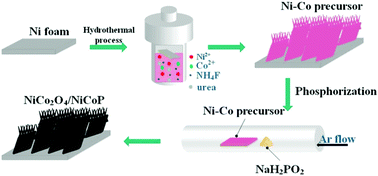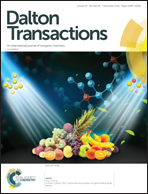NiCo2O4/NiCoP nanoflake-nanowire arrays: a homogeneous hetero-structure for high performance asymmetric hybrid supercapacitors†
Abstract
Transition metal phosphides (TMPs) represent an important class of compounds with metalloid characteristics and good electrical conductivity, which are of great benefit to enhance electrochemical performances. Thus it is important to clarify the correlation between the electrochemical properties and the phosphating degree of the precursor. Herein, we report a superior electrode for battery-like capacitors based on NiCo2O4/NiCoP hetero-structure nanoflake-nanowire arrays grown on nickel foams using a one-pot facile hydrothermal approach and a controllable phosphorization treatment method. The Ni–Co precursor nanoflake-nanowire array based electrode treated with 500 mg NaH2PO2 shows significantly improved electrochemical performances with an ultrahigh specific capacitance of 2288.8 F g−1 and 1644 F g−1 at a current density of 1 A g−1 and 20 A g−1, respectively. The electrode also shows superior cycling stability. In addition, the NiCo2O4/NiCoP//AC device exhibits a relatively high energy density of 35.5 W h kg−1 at 750.4 W kg−1. The results suggest that this NiCo2O4/NiCoP nanoflake-nanowire array is a promising electrode material for high performance hybrid supercapacitor applications.



 Please wait while we load your content...
Please wait while we load your content...